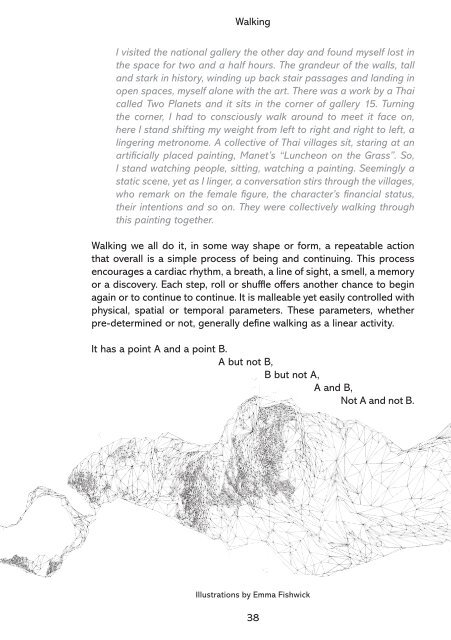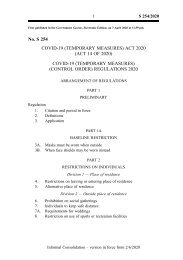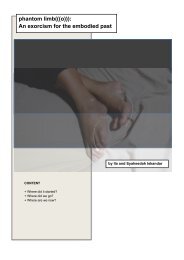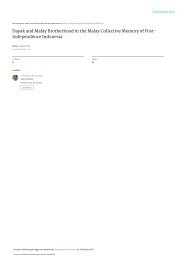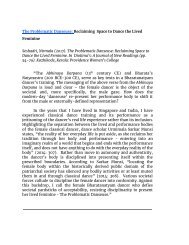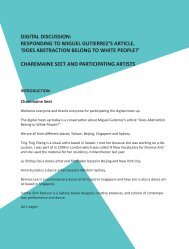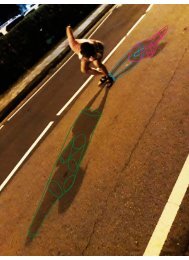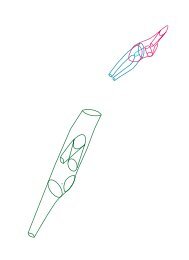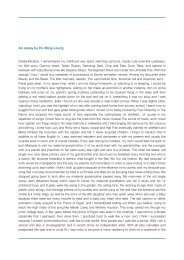FUSE#5
This edition of FUSE consists of articles contributed by artists who participated in Dance Nucleus' programmes in 2020.
This edition of FUSE consists of articles contributed by artists who participated in Dance Nucleus' programmes in 2020.
You also want an ePaper? Increase the reach of your titles
YUMPU automatically turns print PDFs into web optimized ePapers that Google loves.
FUSE #5<br />
For author Rebecca Solnit, walking is “a bodily labour that produces<br />
nothing but thoughts, experiences, arrivals… the mind, the body and<br />
the world are aligned, as though they were three characters finally in<br />
conversation together, three notes suddenly making a cord” (Solnit,<br />
2002, p. 5). It offers a form of embodied movement that responds,<br />
connects and shifts ways of thinking, making, seeing and moving and<br />
approaches physical landscapes as “sensory environments… constructed<br />
and understood through kinaesthetic motion” (Rogers, 2012, p. 63).<br />
Doris Humphrey did it as a procession (1928)<br />
Bruce Nauman did it in an Exaggerated Manner (1967)<br />
Richard Long did it backwards (1967)<br />
Trisha Brown did it up and down walls (1971),<br />
Anna Halprin did it in mandalic circles (1987)<br />
James Cunningham does it slow, isolated and performatively (2010–)<br />
Amanda Heng did it so every step counted (2019–2020)<br />
Walking is choreographic, it is rhythm, it offers multiplicity in thinking<br />
processes, it is simple and has the ability to take the body and press it<br />
up against, submerge in and on top of the place in which it finds itself<br />
in. Walking is historical, its durational, repetitious, idle, spatial, temporal,<br />
political and cultural. It is primal, yet not quite universal. For those that<br />
cannot walk, can it still be universal if it is not bound to the body alone?<br />
Can walking be evident without the body? Can process be a long walk?<br />
I visited the national gallery the other day, Sunday 1st March and<br />
found myself wandering throughout the gallery space for two and a<br />
half hours. The grandeur of the walls, tall and stark in history lead<br />
me up winding up back stair passages. So quiet and empty I felt I<br />
was intruding until I’d land in the open spaces, alone with the art.<br />
About one and a half hours in, I came across a video work by a Thai<br />
artist Araya Rasdjarmrearsnook called Two Planets (2008) and it<br />
sits in Gallery 15. Turning left into the gallery I noticed it placed<br />
in the far-right hand corner of the room, I had to consciously walk<br />
around three or four other artworks to meet it face on. Here I stand<br />
shifting my weight from left to right and right to left, a lingering<br />
metronome in front of two TV screens. On one of these screens, is<br />
a collective of Thai villages, who sit, staring at an artificially placed<br />
painting mounted on an easel in a clearing amongst the bamboo.<br />
It was Manet’s Luncheon on the Grass (1863). It’s the notorious<br />
one, that features two men in their gentlemanly attire, one lady off<br />
39


